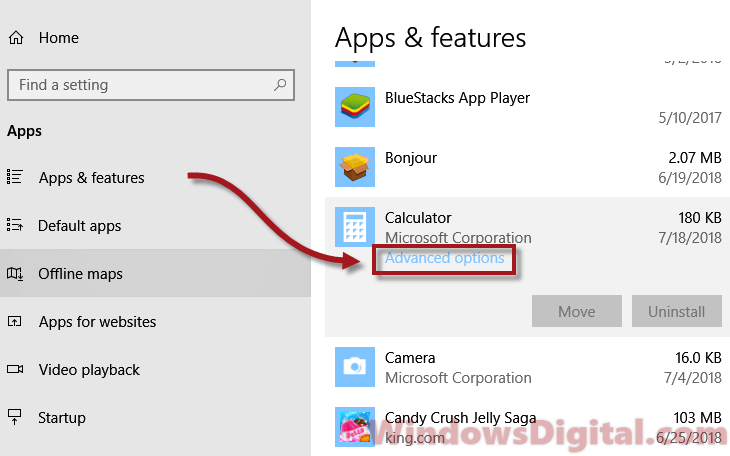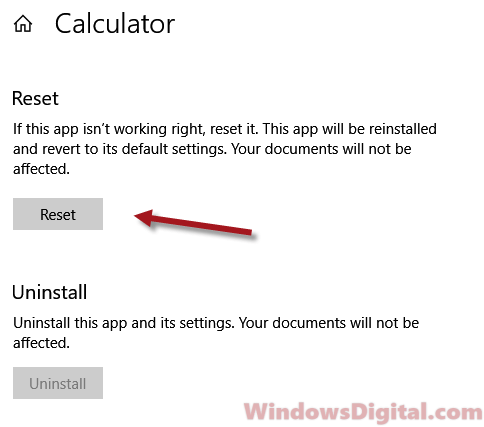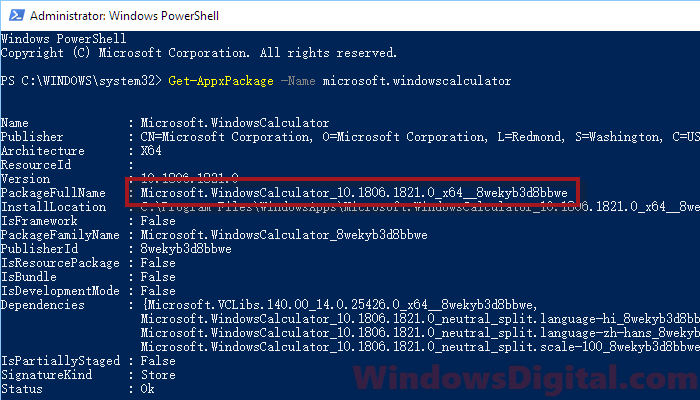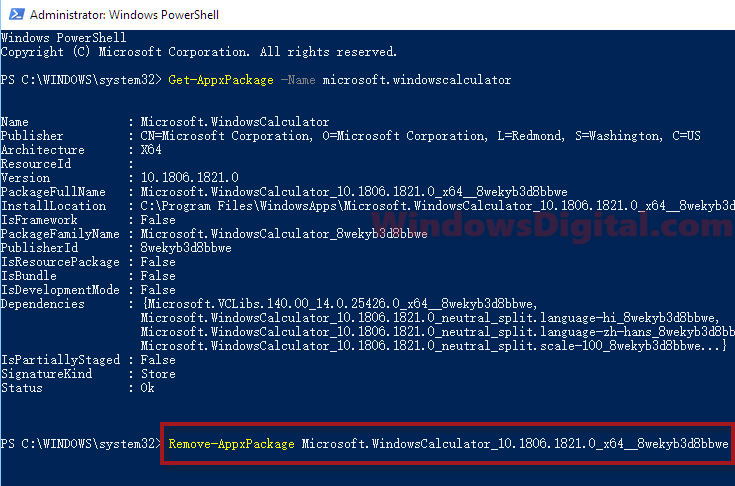Microsoft has replaced most of its legacy apps with modern apps in Windows 10 and Windows 11. This includes the Calculator app. Sometimes the Calculator app goes missing or is mistakenly uninstalled from the operating system.
It may also be possible that the files required to run the app are present on your PC, but the app itself doesn’t show up.
In this article, we will discuss how to fix Windows 10 calculator missing or how to install it again using different methods.
Table of Contents
Install Calculator App on Windows
If your computer does not have the Calculator or has accidentally been deleted, there are multiple ways you can fix it. It can be reinstalled, or the current installation can be restored.
From Microsoft Store
You can download and install the application from the Microsoft Store. Note that you must be signed in to your profile using a Microsoft account to install the app.
Follow these steps to install the Calculator app from Microsoft Store:
-
Open the Windows Calculator app page in Microsoft Store and click Get in Store app.
Get in Microsoft Store -
You will now be prompted to open the Microsoft Store app. Click Open Microsoft Store.
Open in Store -
The Store app will now open showing the Windows Calculator page. Click Get to install the app.
Get the Windows Calculator app The app will now begin downloading and installing.
-
When the installation is finalized, click Open.
Open Windows Calculator
The Calculator app should now be installed on your PC.
Using Windows PowerShell
Alternatively, you can also install the Windows Calculator app through Windows PowerShell using a single cmdlet.
Simply run the following cmdlet in an elevated PowerShell instance to install Windows Calculator:
Get-AppXPackage *WindowsCalculator* -AllUsers | Foreach {Add-AppxPackage -DisableDevelopmentMode -Register "$($_.InstallLocation)\AppXManifest.xml"}
After the app is installed, it can be accessed by searching for it from the Start menu or the search box in the taskbar. Alternatively, you can also type in calc in the Run Command box to launch the Windows Calculator app.
However, if this method did not work for you and it shows that the app is already installed but not showing up in your search results, then there are other methods to fix the problem.
Fix Calculator App Not Working
Uninstall and Reinstall Calculator App
Some users have reported that the Windows Calculator has somehow gone missing on their computers. However, upon trying to reinstall it using the method shared above, they are prompted with “The app is already installed.”
This is the perfect example of the installation packages remaining on the system, but the application is either removed or corrupted.
If you are in a similar situation, follow these steps to mitigate the issue and reinstall Windows Calculator:
-
Open Windows PowerShell with elevated privileges and run the following cmdlet:
get-appxpackage *Microsoft.WindowsCalculator* | remove-appxpackageUninstall Windows Calculator from PowerShell This will remove all traces of the Calculator app from your PC.
-
Now, run the following cmdlet to reinstall the Windows Calculator app:
Get-AppXPackage *WindowsCalculator* -AllUsers | Foreach {Add-AppxPackage -DisableDevelopmentMode -Register "$($_.InstallLocation)\AppXManifest.xml"}
Once the Calculator app is reinstalled, check to see if you can run it. This method usually solves the issues.
However, if you find that the method has failed, you can try the given solutions discussed below.
Run Windows Store Troubleshooter
The Windows operating system comes with built-in troubleshooters for different components. It also has a combined troubleshooter for all Microsoft Store applications. If you find that the Calculator app is installed but not running, you can run the Windows Store troubleshooter. Here is how:
-
Navigate to the following:
Settings app >> Update & security >> Troubleshoot >> Additional Troubleshooters
-
Here, scroll down and click “Windows Store Apps” to expand it, and then click Run the Troubleshooter.
Run Windows Store applications troubleshooter The troubleshooting wizard will now run. As it does, it will automatically scan and detect any problems with any of the apps.
-
Once this scan is complete (takes only a few seconds), it will recommend some actions to take or perform the less complex actions automatically to mitigate any detected issues. Follow the on-screen instructions and perform the necessary actions to fix the problem.
Once done, close the wizard.
Now check to see if the problem has been solved and if you are able to run the Windows Calculator app.
Check for Updates
The first approach should be to check for any pending updates, both in Windows Updates as well as the Microsoft Store. Any pending updates can cause an application to malfunction.
-
Open Microsoft Store and click on the Pending updates button in the top-right corner of the app.
If you do not see this button, it means your applications are already up to date.
-
Now click on Update all to begin updates for all Microsoft applications on your computer.
Install Store updates
Once all the applications have been updated, including Windows Calculator, relaunch the application and check if the error is resolved.
Run the System File Checker (SFC)
The System File Checker (SFC) is a preinstalled Command Prompt tool in Windows that attempts to repair corrupted system files by replacing them with redundant files. However, this also requires that the system image is healthy, so it can perform a successful repair.
SFC is a mechanism of the Windows File Protection feature.
Simply run the following cmdlet in an elevated Command Prompt and the tool will do the rest:
sfc /scannow
The command will take a while to execute completely. When done, recheck if the Windows Calculator is functional now.
Reset the Windows Calculator App
If the method above did not work for you, try resetting the Calculator app. This will bring the app back to its default state.
-
Navigate to the following:
Settings app >> Apps
-
Here, search for “calculator” in the text field.
Search for Calculator -
Now click on the Calculator app below and then click Advanced Options.
Open advanced Calculator options -
On the next screen, scroll down and click Reset.
Reset the Calculator app -
When asked for confirmation, click Reset again.
Confirm reset The app will now reset to its default settings, removing all data and cache.
After the Windows Calculator app has reset, check to see if you are able to run it.
Update Windows OS
If none of these solutions have worked so far, then try updating your Windows 10 operating system through Windows Updates, since Microsoft often publishes app updates through the Windows Update as well.
Install any pending updates using these steps:
-
Navigate to the following
Settings app >> Update & Security >> Windows Update
-
Now click Check for updates.
Check for pending updates -
If any updates show up, we suggest that you install them.
-
Once installed, restart the computer and check to see if it resolved the Windows Calculator app problem.
The given solutions ought to fix any issues with the Calculator app. Let us now move on to other useful tips for the app.
Create Shortcut and Assign Shortcut Keys to Calculator App
Using shortcut keys to perform simple tasks has always been our favorite in Windows 10. However, by default, there are no shortcut keys assigned to the Windows Calculator app. We can assign a combination of keys using which we can open the Calculator app from anywhere.
The method shared below will create a Calculator shortcut on your desktop and assign shortcut keys to it.
-
Right-click on a blank space on the desktop, expand New from the context menu, and then click Shortcut.
Create new shortcut -
Now enter the following path in the location text field inside the Create Shortcut wizard, and then click Next.
C:\Windows\System32\calc.exe
Enter path to Calculator app -
On the next screen, enter a name for the shortcut and click Finish.
Assign a name to the shortcut -
You will now see a Calculator icon on your desktop. Right-click it and then click Properties from the context menu.
Open shortcut properties -
In the Properties window, click on the text field in front of the Shortcut Key under the Shortcut tab, and then press the shortcut keys which you wish to set.
In this example, we have set it to set Ctrl + Shift + C.
Assign shortcut keys When done, click Apply and Ok.
Now you can access the Windows Calculator simply by pressing the shortcut keys from anywhere within Windows, or through the shortcut icon on your desktop.
What Windows Calculator Offers
Unlike our physical calculators, the Windows Calculator consists of various other features that can be used for the user’s convenience. Let us see what some of these handy features are.
Upon launching the application, you will see a window such as the one shown below.
Apart from the basic calculations which can be performed from the keypad, the top bar consists of various features.
You can check the old calculations performed by clicking the clock-like icon on the top-right, or clicking on the middle button to keep the calculator always on top of other applications.
The Standard indicates that the calculator is currently in Standard mode, which can be changed by clicking on the three bars left of it.
Upon clicking the three bars, you are presented with a list of options to choose from. The calculator can be converted into the Scientific mode for more complex calculations, or into Graphical mode to plot graphs from equations. The Programmer mode can be used to convert values between decimals, hexadecimal, octanes, or binary.
Going further down the menu, the calculator also offers a range of different conversions for instant results.
These features indicate that this application can be extremely useful even when performing daily regular tasks.
If you do not like the Windows Calculator app, you can try these alternatives instead.
Closing words
The Windows Calculator is a handy application when it comes to solving complex mathematical equations and conversions. Rather than switching between devices for calculations, Microsoft offers a list of features within its application.
Windows Calculator can also be added to hotkeys for quick access from anywhere within Windows. If the application is missing or malfunctioning on your device, this article offers various fixes on different levels for you to troubleshoot.
How often do you use the calculator on your computer?
If you notice that the built-in Calculator app in Windows 11 or Windows 10 has suddenly gone missing or stops working, especially after a recent Windows update, it might seem like a complicated and confusing issue but it’s easy to bring it back and fix any issues it has.
In this guide, we will show you some workarounds and solutions you can try to restore the Calculator app and fix any problems with it on Windows 11 or 10.
How to fix Calculator app missing or not working
The Microsoft Calculator app comes pre-installed with your Windows 10 or 11 installation. You can open it by simply searching for it in the Start menu. You can also pin it to your taskbar or create a shortcut on your desktop so that you can quickly open it.
If the app suddenly disappears from all these places and you can’t even find it with Cortana, it could mean that it was accidentally uninstalled or it has become corrupted perhaps due to recent changes in your Windows system. Below are some methods to bring back the Calculator app and to fix any issues it might have.
Reset Calculator app in Windows 11 or 10
The first thing to try is to reset the Calculator app in Windows 10 or 11 entirely. By resetting the app, all of its settings will be reverted to its factory default, which may solve your Calculator app not working issue. Here’s how to reset it:
- Press Win+i to open the Settings app.
- Select Apps.
- From the left pane, select Apps & features.
- Now, on the right pane, scroll down and look for Calculator from the list of apps.
- Select it, then click on Advanced options.
- In the Calculator settings window, under Reset, click on the Reset button.
- Restart your PC.
After rebooting your computer, retry launching the Calculator app in Windows 10 or 11 again and see if your problem is fixed.
Reinstall Calculator app in Windows
If you can’t see the Calculator app from the list of apps or the above method doesn’t work to solve your Windows 10 or 11 Calculator app not working or missing issue, try reinstalling the Calculator app using Windows PowerShell. Here’s how to do it:
- Go to the Start menu or Cortana and search for Windows PowerShell. Right-click it and select Run as administrator.
- In PowerShell, type the following command:
Get-AppxPackage -Name Microsoft.WindowsCalculator
This command is to show the Windows 10 or 11 Calculator app package info. We need the package full name in order to remove the Calculator app. From what you see in PowerShell, copy the entire line of PackageFullName.
- Next, type the following command with your version of PackageFullName. Do not copy the following command. Only use the Remove-AppxPackage command with the package full name you copied earlier:
Remove-AppxPackage Microsoft.WindowsCalculator_10.1806.1821.0_x64__8wekyb3d8bbwe
After executing the command, the Windows 10 or 11 Calculator app should be uninstalled and removed from your PC entirely. Now, you will have to install it again from the Microsoft Store.
- Go to the Start menu. Search for Microsoft Store and open it.
- In the store, search for Windows Calculator. Select it and then click on the Get button to install the Windows 10 or 11 Calculator app. Alternatively, you can also try other Calculator apps developed by third parties by searching for “calculator” in the Microsoft Store.
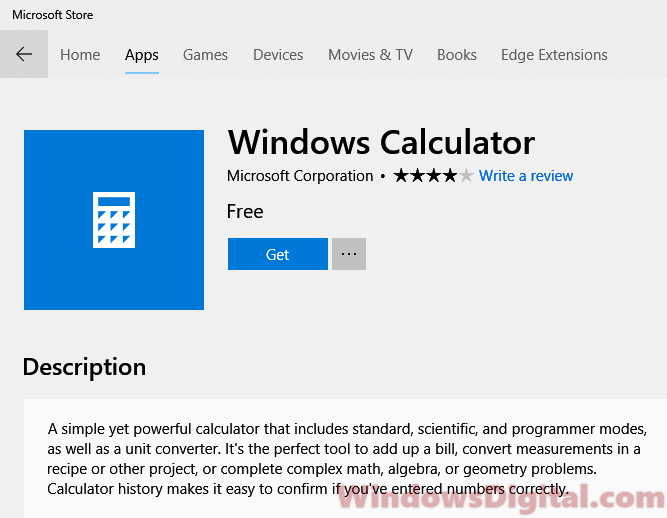
This method should solve any issue with the Windows 10 or 11 Calculator app not working or missing problem.
Linked issue: Get-AppxPackage is Not Recognized or Access is Denied
Reinstall all Windows default apps
We do not recommend this method as it will also wipe all other default apps in Windows 10 or 11 and reinstall them. If you can’t get the PackageFullName to remove only the Calculator app as guided above, or the command above just doesn’t work, here’s a universal command to reinstall all default apps in Windows 10 or 11 at once.
Open Windows PowerShell with admin privileges as outlined above, and then enter the following command:
Get-AppXPackage | Foreach {Add-AppxPackage -DisableDevelopmentMode -Register "$($_.InstallLocation)\AppXManifest.xml"}
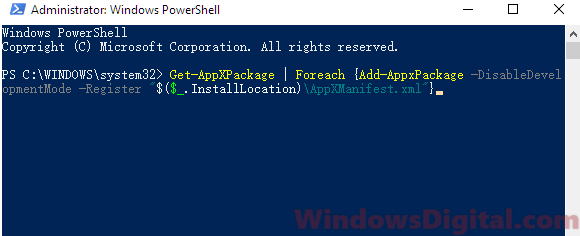
The above command will reinstall all default apps, including the Calculator app, in Windows 10 or 11 for the current user account. If you want to reinstall all Windows apps for all accounts on your PC, run the following command instead:
Get-AppXPackage -AllUsers | Foreach {Add-AppxPackage -DisableDevelopmentMode -Register "$($_.InstallLocation)\AppXManifest.xml"}
This method is known to be the most widely-used “fix all” option when users have issues with their Windows 10 or 11 default apps, such as the Calculator app not working or missing problem.
Are you facing issues with Windows 10 calculator? Is it not working or won’t open? Don’t worry if you’re facing an issue with Windows 10 Calculator such as it won’t open or Calculator doesn’t work then you need to follow this guide to fix the underlying issue.

Windows operating system has always provided with some iconic utility applications such as paint, calculator and notepad. The calculator is one of the most useful applications that Windows provides. It makes the work easy & fast, and the user does not have to operate on any physical calculator; rather, the user can access the in-built calculator in Windows 10. Sometimes, the Windows 10 Calculator won’t work to deal with such a problem; there are many easy ways to quickly resolve it.
Table of Contents
Make sure to create a restore point just in case something goes wrong.
Method 1: Reset Windows 10 Calculator
If any application in Windows 10 is not working then to deal with this, the best solution is to reset the application. To Reset the Calculator in Windows 10, follow these steps:
1. Open the Start menu or press the Windows key.
2. Type Apps and Features in Windows Search & then click on the search result.

3. In the new window, search for the Calculator in the list.
4. Click on the application and then click on Advanced options.

5. In the Advanced options window, click on the Reset button.

The calculator will be reset, now again try to open the Calculator, and it should work without any issues.
Method 2: Reinstall the Calculator using PowerShell
The Windows 10 calculator is in-built, and so it cannot be directly deleted from the properties. To reinstall an application first, the application should be deleted. To uninstall calculator & other such applications, you need to use Windows PowerShell. However, this has a limited scope as other applications such as Microsoft Edge, and Cortana cannot be uninstalled. Anyway, to uninstall calculator follow these steps.
1. Type Powershell in Windows Search, then right-click on Windows PowerShell and select Run as administrator.
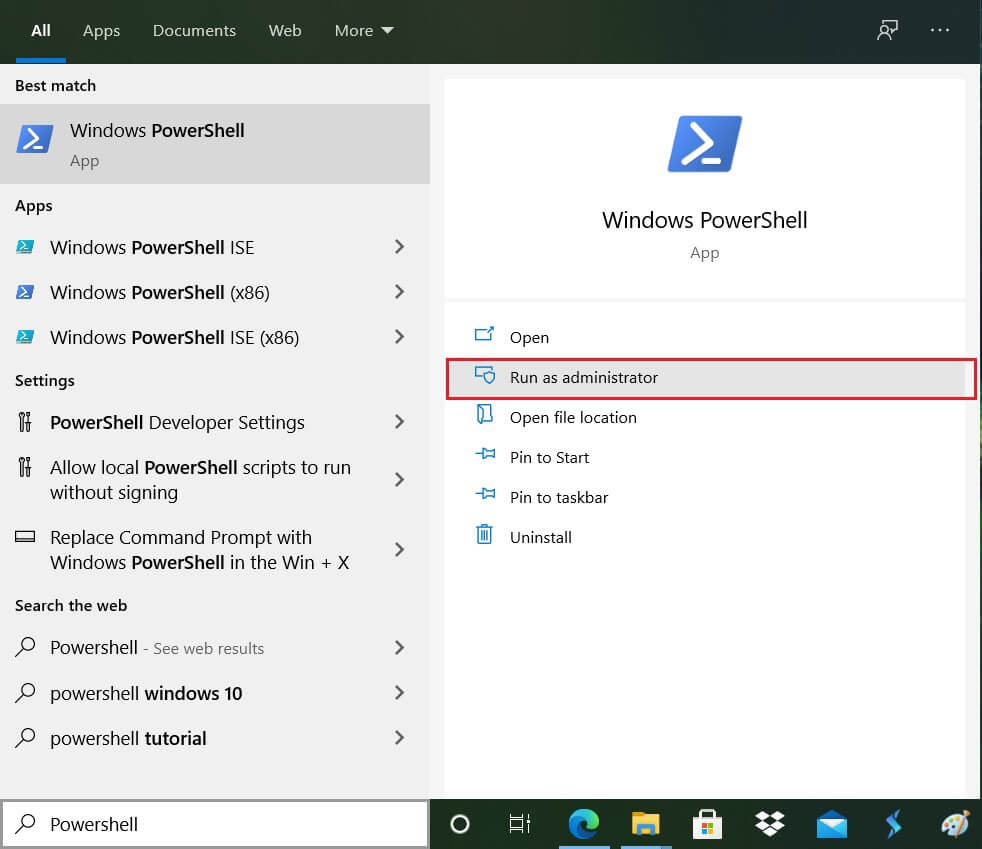
2. Type or paste the following command in the Windows PowerShell:
Get-AppxPackage *windowscalculator* | Remove-AppxPackage

3. This command will successfully uninstall Windows 10 Calculator.
4. Now, to install the Calculator again, you need to type or paste the below command in PowerShell and hit Enter:
Get-AppxPackage -AllUsers| Foreach {Add-AppxPackage -DisableDevelopmentMode -Register“$($_.InstallLocation)\AppXManifest.xml”}

This will install the Calculator in Windows 10 again, but if you want to install the Calculator using Microsoft store then first uninstall it, and then you can install it from here. After reinstalling the calculator, you should be able to Fix Calculator Not Working in Windows 10 issue.
Method 3: Run System File Checker (SFC)
System File Checker is a utility in Microsoft Windows that scans and replaces the corrupted file with a cached copy of files present in a compressed folder in the Windows. To run the SFC scan, follow these steps.
1. Open the Start menu or press the Windows key.
2. Type CMD, right-click on command prompt and select Run as Administrator.

3. Type sfc/scannow and press Enter to run the SFC scan.

4. Restart the computer to save changes.
The SFC scan will take some time and then restart the computer try to open the calculator app again. This time you should be able to Fix Calculator Not Working in Windows 10 issue.
Method 4: Run Deployment Image Servicing and Management (DISM)
DISM is another utility in windows that also works the same way as SFC. If the SFC fails to fix the issue of the calculator, then you should run this service. To run DISM follow these steps.
1. Open Command Prompt. The user can perform this step by searching for ‘cmd’ and then press Enter.
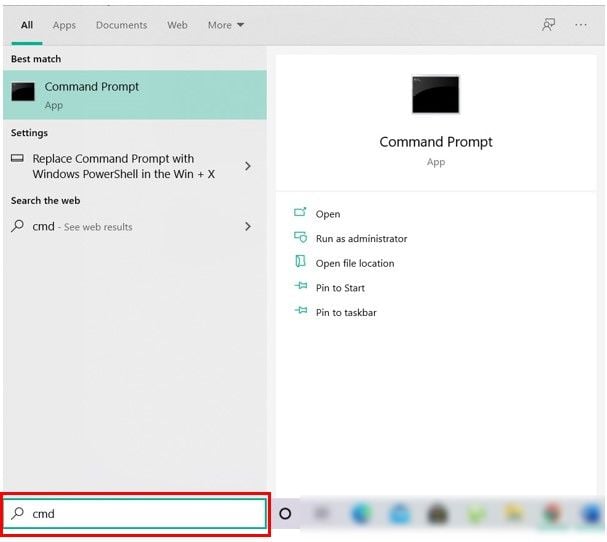
2. Type DISM /Online /Cleanup-Image /RestoreHealth and press enter to run DISM.
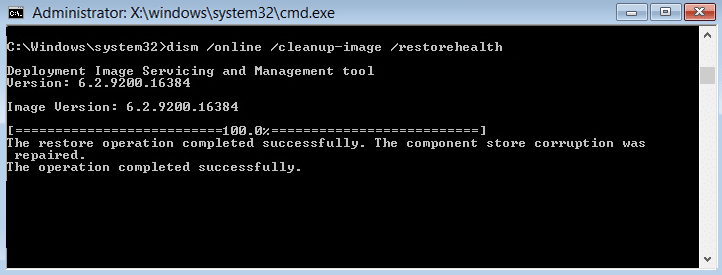
3. The process may take between 10 to 15 minutes or even more dependent upon the level of corruption. Do not interrupt the process.
4. If the above command doesn’t work, then try on the below commands:
Dism /Image:C:\offline /Cleanup-Image /RestoreHealth /Source:c:\test\mount\windows Dism /Online /Cleanup-Image /RestoreHealth /Source:c:\test\mount\windows /LimitAccess
5. After DISM, run the SFC scan again through the method stated above.

6. Restart the system and try to open the calculator & it should open without any issues.
Method 5: Perform System Restore
If the above methods fail to fix the issue, then you can use system restore. A system restores point is a point to which the system rollbacks. The system restores point is created so as if there is some problem in future then the Windows can roll back to this error-free configuration. To perform a system restore, you need to have a system restore point.
1. Type control in Windows Search then clicks on the “Control Panel” shortcut from the search result.
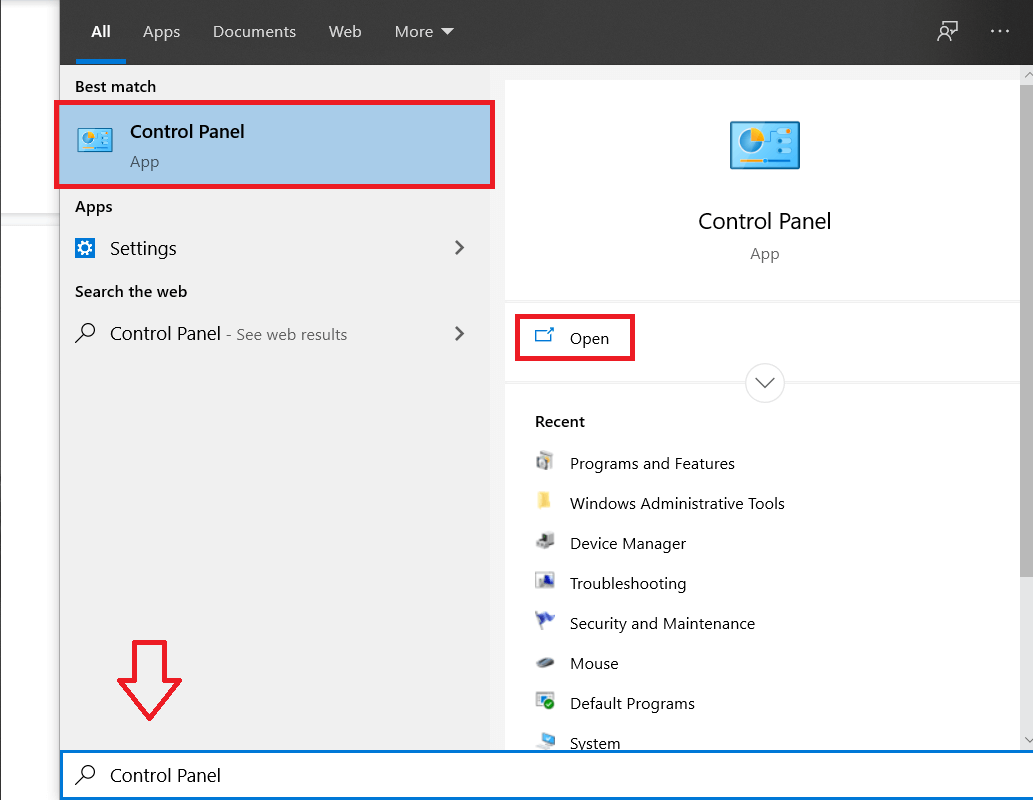
2. Switch the ‘View by’ mode to ‘Small icons’.
3. Click on ‘Recovery’.
4. Click on ‘Open System Restore’ to undo recent system changes. Follow all the steps needed.

5. Now, from the Restore system files and settings window click on Next.

6. Select the restore point and make sure this restored point is created before facing the BSOD issue.
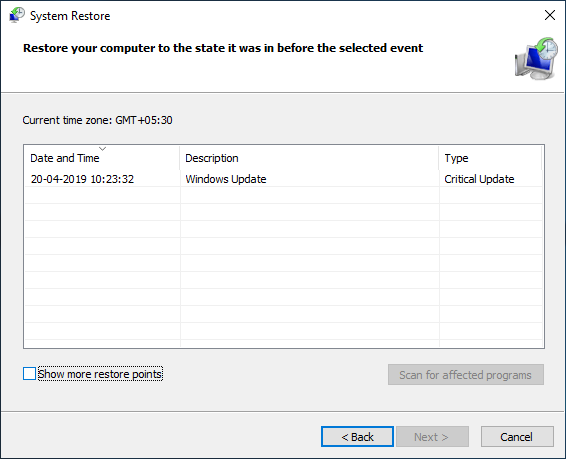
7. If you can’t find old restore points then checkmark “Show more restore points” and then select the restore point.
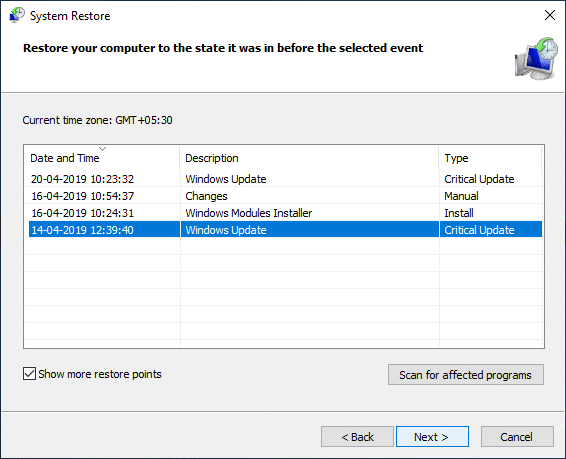
8. Click Next and then review all the settings you configured.
9. Finally, click Finish to start the restore process.

10. Restart the computer and try to open the calculator.
This method will roll back the Windows to a stable configuration, and the corrupted files will be replaced. So this method should Fix Calculator Doesn’t Work in Windows 10 issue.
Method 6: Add a New User Account
If all the above methods have failed, then create a new user account and try to open the calculator in that account. To make a new user account in Windows 10, follow these steps.
1. Press Windows Key + I to open Settings and then click Accounts.

2. Click on Family & other people tab in the left-hand menu and click Add someone else to this PC under Other people.

3. Click, I don’t have this person’s sign-in information at the bottom.

4. Select Add a user without a Microsoft account at the bottom.

5. Now type the username and password for the new account and click Next.

6. Open Start Menu, and you will see the other User’s icon.
7. Switch to that User Account and try to open the Calculator.
Sign in to this new user account and see if the Calculator is working or not. If you are successfully able to Fix Calculator Not Working issue in this new user account, then the problem was with your old user account which might have got corrupted.
Method 7: Use a third-party application
If nothing is working for you, then you can download a third-party Calculator app. This Calculator will work just fine as the Windows 10 Calculator. To download various Calculator apps, you can visit this link and download the application.
Recommended:
- Why do You need To Disable Fast Startup In Windows 10?
- How to Update Device Drivers on Windows 10
- Fix Blue Screen of Death error on Windows 10
- 6 Ways to Access BIOS in Windows 10
I hope this article was helpful and you can now easily Fix Calculator Not Working in Windows 10, but if you still have any questions regarding this tutorial then feel free to ask them in the comment’s section.
The classic Calculator has been replaced with a modern version of Calculator in Windows 10. The new Calculator app in Windows 10 sports a clean user interface and works great on touch devices as well.
In addition to the standard mode that you see by default upon launching the Calculator app with default settings, programmer and scientific modes are also available in the Calculator app. Besides that, the Calculator app includes a converter as well. The converter feature supports volume, length, energy, temperature, weight and mass, angle, pressure, data, time, power, area, and speed.

The Calculator in Windows 10 app usually works well without any issues. Over the last year, the app has been updated several times, and the app is quite stable now.
That said, if you’re having any issues while opening the Calculator app or using it, you can reset the app to fix the issue. If resetting the app didn’t help, you may reinstall Calculator to address the issue.
Refer to the given below directions to reset and reinstall the Calculator app in Windows 10.
Step 1: Open the Settings app and then navigate to System > Apps & features.
Step 2: Look for Calculator app entry. Click on Calculator app entry to see the Advanced options link. Click the Advanced options link.

Step 3: This will open Storage usage and app reset page. Click the Reset button.

Step 4: When you see the warning dialog with “This will permanently delete app’s date on this device, including your preferences and sign-in details” message, click the Reset button again to reset the Calculator app.

A check sign should now appear next to the Reset button, indicating that the reset job is done successfully.
Reinstall the Calculator app via Settings
Step 1: Go to Settings > Apps > Apps & features page.
Step 2: Scroll down the page to see the Calculator entry. Click on the entry to reveal the hidden Uninstall button. Click the Uninstall button.

Step 3: Once the Calculator is installed, launch the Store app, search for Windows Calculator, and then install the same. Simple as that!

Reinstall Calculator app in Windows 10 via PowerShell
The built-in Calculator app can’t be uninstalled like other apps installed from Store. You need to either use the PowerShell or third-party program like CCleaner to uninstall the app. In this guide, we are using both PowerShell and CCleaner to uninstall the Calculator app.
Step 1: Open PowerShell with admin rights. To do so, type PowerShell in Start menu or taskbar search box, right-click on PowerShell entry, and then click Run as administrator.

Step 2: Copy and paste the following command in the PowerShell window and then press the Enter key to execute the same.
Get-AppxPackage –AllUsers

Step 3: Now, look for Microsoft.WindowsCalculator name.

To quickly find its entry, right-click on the title bar of PowerShell, click Edit and then click Find. Enter Calculator in the box and then click Find the next button.

Step 4: Copy the PackageFullName of WindowsCalculator by selecting it as shown in the picture below and then simultaneously pressing Ctrl + C hotkey.

Step 5: Finally, execute the following command to uninstall Calculator from your Windows 10 install.
Remove-AppxPackage PackageFullName
In the above command, replace PackageFullName with the PackageFullName of Calculator that you copied in the previous step. That’s it!

Step 6: Visit this page of Windows Store, click Install button to download install the official Calculator app again. As simple as that!

Using CCleaner to uninstall Calculator
Alternatively, if you’re not familiar with the PowerShell, download, install and run CCleaner, click Tools, click Uninstall, select Calculator from the list and then click the Uninstall button. Click Yes button when you see the confirmation dialog to uninstall Calculator.

Once uninstalled, visit this page of Store and install a fresh copy of Calculator.
Check out the full list of Windows 10 Calculator keyboard shortcuts.
Reinstall the Calculator App in Windows 10 with PowerShell
The calculator app is a handy tool that comes pre-installed on Windows 10. However, if you ever accidentally delete it or it becomes corrupted, you can easily reinstall it using PowerShell.
PowerShell is a powerful command-line tool that can be used to manage and configure Windows. It’s also a great way to reinstall the calculator app if you need to.
In this article, I’ll show you how to reinstall the calculator app in Windows 10 using PowerShell. I’ll also provide a few tips on how to use PowerShell to manage your Windows 10 system.
So if you’re ready to learn how to reinstall the calculator app in Windows 10 with PowerShell, keep reading!
| Header 1 | Header 2 | Header 3 |
|---|---|---|
| Data 1 | Data 2 | Data 3 |
| Data 4 | Data 5 | Data 6 |
| Command | Description | Example |
|---|---|---|
| `Get-AppxPackage -Name Microsoft.WindowsCalculator | Remove-AppxPackage -AllUsers` | This command will uninstall the Calculator app from all users on the computer. | `Get-AppxPackage -Name Microsoft.WindowsCalculator | Remove-AppxPackage -AllUsers` |
| `Add-AppxPackage -Path C:\Windows\SystemApps\Microsoft.WindowsCalculator_10.22000.1941.0_x64__8wekyb3d8bbwe.appx` | This command will reinstall the Calculator app from the specified path. | `Add-AppxPackage -Path C:\Windows\SystemApps\Microsoft.WindowsCalculator_10.22000.1941.0_x64__8wekyb3d8bbwe.appx` |
The calculator app is a built-in app on Windows 10 that allows users to perform basic and advanced calculations. However, if the calculator app is not working properly or has been deleted, you can reinstall it using PowerShell.
PowerShell is a command-line interface that allows you to manage and configure Windows 10. It can also be used to install and uninstall apps.
This guide will show you how to reinstall the calculator app using PowerShell.
To reinstall the calculator app using PowerShell, follow these steps:
1. Open PowerShell as an administrator.
To do this, click the Start button and type “PowerShell”. Then, right-click the “Windows PowerShell” app and select “Run as administrator”.
2. Run the following command:
Get-AppxPackage -Name Microsoft.WindowsCalculator | Remove-AppxPackage -Verbose
Add-AppxPackage -Path “C:\Program Files\WindowsApps\Microsoft.WindowsCalculator_
This command will first remove the calculator app from your computer. Then, it will reinstall the app from the Windows App Store.
3. Verify that the calculator app has been reinstalled.
To do this, open the Start menu and search for “calculator”. The calculator app should now be listed in the results.
In this guide, you learned how to reinstall the calculator app using PowerShell. This is a useful skill to know if the calculator app is not working properly or has been deleted.
For more information on PowerShell, please refer to the following resources:
- [PowerShell documentation](https://docs.microsoft.com/en-us/powershell/)
- [PowerShell tutorial](https://docs.microsoft.com/en-us/powershell/tutorial/)
- [PowerShell reference](https://docs.microsoft.com/en-us/powershell/reference/)
How to reinstall the Calculator app in Windows 10 using PowerShell
The Calculator app is a built-in app in Windows 10. It’s a handy tool for performing basic calculations, such as addition, subtraction, multiplication, and division. However, if the Calculator app is not working properly, you can reinstall it using PowerShell.
To reinstall the Calculator app using PowerShell, follow these steps:
1. Open PowerShell as an administrator. To do this, press Windows+X and select Windows PowerShell (Admin).
2. Type the following command and press Enter:
Get-AppxPackage -Name Calculator | Remove-AppxPackage
This command will uninstall the Calculator app.
3. Type the following command and press Enter:
Add-AppxPackage -Path “C:\Program Files\WindowsApps\Microsoft.WindowsCalculator_10.20127.1001.0_neutral_~_8wekyb3d8bbwe.appxbundle”
This command will reinstall the Calculator app.
4. Restart your computer.
Once your computer has restarted, the Calculator app should be working properly again.
Troubleshooting
If you’re having trouble reinstalling the Calculator app using PowerShell, here are a few things you can try:
- Make sure that you’re running PowerShell as an administrator.
- Make sure that you’re using the correct path to the Calculator app’s .appxbundle file.
- Try restarting your computer.
- Try reinstalling the Calculator app using the Windows Store.
If you’re still having trouble, you can contact Microsoft support for help.
The Calculator app is a useful tool for performing basic calculations. If the Calculator app is not working properly, you can reinstall it using PowerShell. By following the steps in this article, you can quickly and easily get the Calculator app working again.
Q: How do I reinstall the calculator app in Windows 10 using PowerShell?
A: To reinstall the calculator app in Windows 10 using PowerShell, follow these steps:
1. Open PowerShell as an administrator.
2. Type the following command and press Enter:
Get-AppxPackage -Name Microsoft.WindowsCalculator | Remove-AppxPackage -AllUsers
3. Type the following command and press Enter:
Add-AppxPackage -Path “C:\Program Files\WindowsApps\Microsoft.WindowsCalculator_11.2200.20231.0_x64__8wekyb3d8bbwe\Calculator.appx”
4. Restart your computer.
Q: What are the benefits of reinstalling the calculator app using PowerShell?
A: There are several benefits to reinstalling the calculator app using PowerShell, including:
- Speed: The PowerShell command to reinstall the calculator app is much faster than the traditional method of reinstalling the app from the Microsoft Store.
- Accuracy: The PowerShell command is more accurate than the traditional method of reinstalling the app, as it ensures that the correct version of the app is installed.
- Simplicity: The PowerShell command is simple to use, even for users who are not familiar with PowerShell.
Q: What are the risks of reinstalling the calculator app using PowerShell?
A: There are no known risks associated with reinstalling the calculator app using PowerShell. However, it is always possible that an error could occur during the reinstallation process, resulting in the calculator app not being reinstalled correctly.
Q: What are the steps to uninstall the calculator app in Windows 10 using PowerShell?
A: To uninstall the calculator app in Windows 10 using PowerShell, follow these steps:
1. Open PowerShell as an administrator.
2. Type the following command and press Enter:
Get-AppxPackage -Name Microsoft.WindowsCalculator | Remove-AppxPackage -AllUsers
Q: What are the different ways to open the calculator app in Windows 10?
A: There are several ways to open the calculator app in Windows 10, including:
- Click the Start button and type “calculator”.
- Press the Windows key + R to open the Run dialog box, type “calc” and press Enter.
- Right-click the taskbar and select “Calculator”.
- Open the Windows Search bar and type “calculator”.
- Use the Windows 10 keyboard shortcut Win + Alt + C to open the calculator app.
In this blog post, we have discussed how to reinstall the calculator app in Windows 10 using PowerShell. We first showed how to uninstall the calculator app using PowerShell, and then we showed how to reinstall the calculator app using PowerShell. We hope that this blog post has been helpful for you. If you have any questions, please feel free to leave a comment below.
Author Profile
-
Hatch, established in 2011 by Marcus Greenwood, has evolved significantly over the years. Marcus, a seasoned developer, brought a rich background in developing both B2B and consumer software for a diverse range of organizations, including hedge funds and web agencies.
Originally, Hatch was designed to seamlessly merge content management with social networking. We observed that social functionalities were often an afterthought in CMS-driven websites and set out to change that. Hatch was built to be inherently social, ensuring a fully integrated experience for users.
Now, Hatch embarks on a new chapter. While our past was rooted in bridging technical gaps and fostering open-source collaboration, our present and future are focused on unraveling mysteries and answering a myriad of questions. We have expanded our horizons to cover an extensive array of topics and inquiries, delving into the unknown and the unexplored.

















